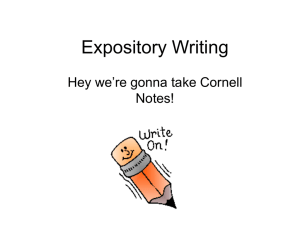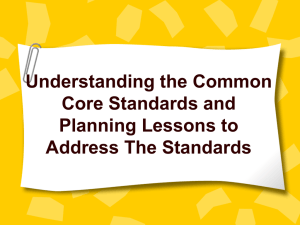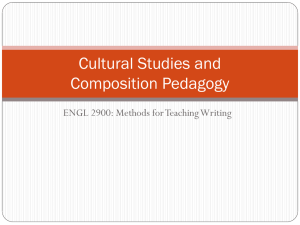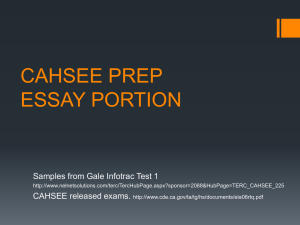CoreContentCoaching-Grade64th6weeks
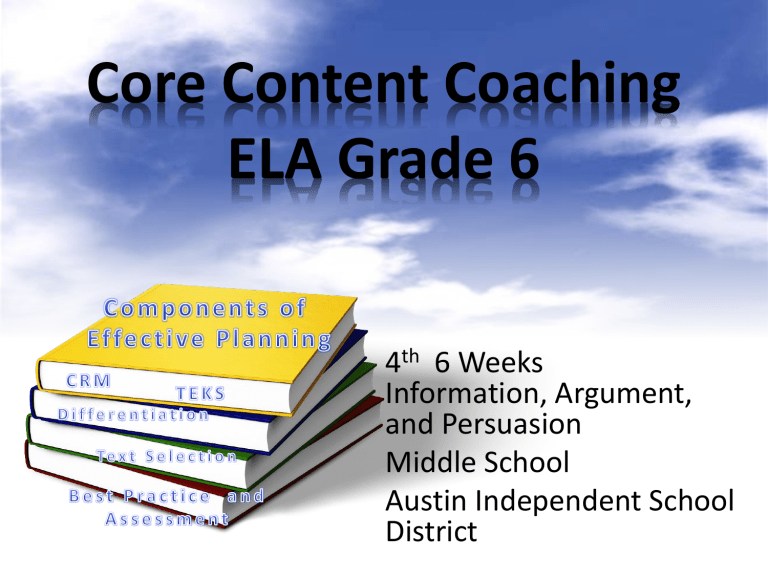
Core Content Coaching
ELA Grade 6
4 th 6 Weeks
Information, Argument, and Persuasion
Middle School
Austin Independent School
District
What you may need:
• School Calendar/Yearly Itinerary (YI)
• Curriculum Road Map (CRM)/Street View
• TEKS/ELPS/CCRS
• STAAR Released Sample Items
• Adopted Text Book
• A resource for quality texts
• A resource for higher order question stems
• Lesson plan template
• AISD Gradual Release Model
• Planning for Rigor Document
• …and most especially, EACH OTHER!
Truly Beginning with the End In
Mind….
Grading Period 4 Desired Results:
Gathering Information to Make a Good Argument
Writing is the most important tool ever created for sharing information, ideas, and opinions. But just like any tool, some people wield it more effectively than others. Some authors learn how to organize
information effectively for their audience, choose words carefully to form a convincing argument, and persuade their readers to change their opinions, beliefs, or behavior. Students will learn the art of research and informational and persuasive writing.
Students will develop an intellectual curiosity about issues relevant to their lives. They will learn how to delve deeply into those topics,
researching information from a variety of sources. They will practice
synthesizing information and presenting it to an audience. And they will learn tools of persuasion to convince others to change beliefs or behaviors.
Before we look at the focus
TEKS for this grading period….
Please remember that although the focus has shifted from
story elements, to literary nonfiction, to writing personal
narratives, author’s craft, and now to research and
persuasion there are several things which should be incorporated EVERY class period in order for students to internalize these skills, daily practice of: Teacher Modeling and Student Practice EVERY DAY!
*Daily Practice can be as
1) Drawing Conclusions
2) Making Inferences
3) Creating Summaries
4) Independent Reading
5) Fluency Practice simples as informal verbal discussions or exit tickets to more formal written open responses to explicit questioning of these standards.
Focus Reading TEK for 4
th
Grading Period
Focus Reading TEKS for1
st
week:
Focus Writing TEK for 4
th
Grading
Period:
Teacher Note about Writing
Focus
In the 3 rd grading period, the writing focus was on author’s craft (metaphors, sensory and figurative language, style, tone, voice). This is an excellent perspective from which to begin the transition to expository writing and persuasive writing in this 4 th grading period. These elements of author’s craft are an excellent foundation for writing informational and adding effective persuasive techniques to persuasive writing.
Vertical Alignment of Focus
Reading TEK…
Students understand, make inferences and draw conclusions about how an author's sensory language creates imagery in literary text and provide evidence from text to support their understanding.
Students are expected to……
5 th Grade 6 th Grade 7 th Grade 8 th Grade 9 th Grade/Eng I
5.11C analyze how the organizational pattern of a text
(e.g., cause-effect, compare-andcontrast, sequential order, logical order, classification schemes) influences the relationships among the ideas.
Readiness
6.10C explain how the different organizational patterns (e.g., preposition-andsupport, problemand-solution) develop the main idea and the author’s viewpoint.
Readiness
7.10C use different organizational patterns as guides for summarizing and forming and
overview of different kinds of expository text.
Readiness
8.10C make subtle inferences and draw complex conclusions about the ideas in text and their organization patterns.
Readiness
E1.9C make subtle inferences and draw complex conclusions about the ideas in text and their organization patterns.
Readiness
Recurring TEKS
In EVERY text,
ALL the time!
Readiness for all grades in Fiction and Expository Supporting for Literary Nonfiction:
Fig 19D make inferences about text and use textual evidence to support understanding
Fig 19E summarize, paraphrase, and synthesize (new starting in 6 th ) in ways that maintain meaning and logical order a text and across texts.
6
th
Grade Week 1
6.10 Students analyze, make inferences and draw conclusions about expository text and provide evidence from text to support their understanding.
Students are expected to……
(C) explain how different organizational patterns
(e.g., proposition-and-support, problem-andsolution) develop the main idea and the author's viewpoint
Let’s deconstruct…..
Deconstruct the TEKS
Cognitive Demand
Find the verb(s) stated in the
Knowledge and Skill and the
SE.
Concept
Find the noun of the TEKS and SE
Context
In what context do the TEKS and SE require the concept be taught?
Analyze Expository Text In a Variety of Expository
Texts
Make Inferences Organizational Patterns
Draw Conclusions Proposition-and-Support
Within Research and Critical
Reading of Text
Provide Evidence to Support
Understanding
Provide Evidence
Support Understanding
Explain
Develop
Problem-and-Solution
Main Idea
Author’s Viewpoint
Distinguishing between Fiction and Expository
Narrative Expository
*Events that move through time
*About the speaker
Dialogue
Conflict
Characters
Events
Reflections
Feelings
Imagery
Setting
*Answers the questions How and Why
*About the subject
Details
Compare/contrast
Cause/effect
Definition
Lists
Classifies information
Examples
Explains
Explores
Examines
Experience
Exposes
Expands
Guiding Questions….
• Guiding Questions are: derived from Enduring Understandings and
Essential Questions in CRM , include language of the TEK , are narrowed to address specific lesson objectives , and are open ended and conceptual. For example:
Enduring Understanding: Informational texts help readers comprehend facts, world issues, and meaningful ideas, while understanding persuasive texts and techniques enable reader to think critically.
Essential Questions: What are the various types of informational texts, and how can you use information to solve problems, support arguments, or deliver instructions? How do authors organize informational text to achieve different goals?
6.10C Sample 6 th Grade Guiding Questions: Which organizational structure/s did the author choose in this piece and why? What sentence best summarized the controlling idea? Justify your choice. How did the author’s choice of organizational pattern help develop the main idea or support the content? What is the most important thing the author is trying to convey/explain? What text evidence can you find to support your idea?
Text Selection for Expository
Organizational Structures
In addition to the rich collection of expository texts in the HM textbook, there are some other very useful and effective resources for teaching expository text structure:
• Nonfiction and Persuasive Texts (leveled by grade level)
• SERP Word Generation-High Interest Nonfiction texts
• National Geographic Kids
• Time for Kids
• Scholastic News
• Exploring Cause and Effect Using Expository Texts About Natural
Disasters (Lesson from ReadWriteThink.org)
• Exploring Compare and Contrast Structure in Expository Texts
(Lesson from ReadWriteThink.org)
Building Teacher Background
Knowledge
• Here are some resources which you can use to build your own knowledge base or perhaps choose to share with students as you explore expository text structures.
• PowerPoint on Common Text Structures
• Exploring Cause and Effect Using Expository Texts
About Natural Disasters (Lesson from
ReadWriteThink.org)
• Exploring Compare and Contrast Structure in
Expository Texts (Lesson from ReadWriteThink.org)
Instruction and Assessment have a reciprocal relationship…
Our goal this grading period is that:
Students will develop an intellectual curiosity about issues relevant to their lives. They will learn how to
delve deeply into those topics, researching information from a variety of sources. They will
practice synthesizing information and presenting it to an audience. And they will learn tools of persuasion to convince others to change beliefs or behaviors.
• This is the END we have in mind…..
How are we going to TEACH it and how are we going to ASSESS it?
Expository Text Structures:
Ideas for Anchor Charts
• Descriptive Text Structures: Focus on the attributes of something
–
–
–
Sequence
Listing
-organize events in a chronological way.
-Organize actions, events, or specific points with bullets, commas, or numbers.
Classification -Organize a subject into categories or explain
Anchor
Charts created with students confirm baseline background knowledge for unit of study the category into which an item falls.
– Compare/Contrast -Organize information by highlighting similarities and differences.
• Sequential Text Structures: present a series of events from first to last
– Procedural -organize a process so another may follow and either do or understand the process.
– Cause and Effect -Trace the results of an event or the reasons an event happened.
• Problem/Solution -Organize information by defining a problem and then suggesting possible solutions.
• Graphics -use graphs, charts, diagrams, photos, and icons to aid readers’ understanding. Titles and captions when necessary
• Argument/Persuasion -Make a claim and then provide arguments to support or oppose the claim.
Descriptive Text Organizers
Web for information about one thing
Matrix
For comparing and contrasting multiple things
List
Simple series of items
Sequential Text Organizers
Procedural
Similar to list except that elements are linked by time
Cause-Effect: Falling Dominoes
A chain of cause and effect episodes
Cause-Effect:
Branching Tree
When one event has several consequences
Problem Solution and
Persuasive Text Organizers
Problem-Solution
Describe a problem and suggest one or more possible solutions.
May also offer possible outcomes to the solved problems.
Problem Solution
Problem
1.
2.
3.
Argument/Persuasion
Make a claim and then provide arguments to support or oppose
Solution
1.
2.
3.
FOR
Outcomes
1.
2.
3.
Use of cell phones in School
AGAINST
Arc 1 Sample lesson Cycle for Studying Text Structures
I do…..
1)Choose a several short articles of each of the types of text structures listed on slide #17 and then choose a corresponding graphic organizer for that text structure (a large chart size one and student copies). Plan to share one of a descriptive nature first with students in this introduction of the unit.
2) Provide the students each with a copy and conduct a read aloud of the text and after reading it, ask students to notice specific things about the text. Focusing on how the author organized the information?
3) Then put up the graphic organizer for Descriptive Text Structure, such as the Web,
Matrix, or List (from slide 18) and use the content in the article to complete the web with the students providing text evidence from the piece.
So you are modeling and coconstructing the anchor chart together.
Example:
U.S.
Supreme
Court
Rules YES
Some states have banned it while others have notparents have lawsuits
Click on title to read article
Corporal
Punishment
This article lends itself nicely also to when you get to persuasive text structure.
Have students re-read to complete a FOR/AGAINST organizer.
Some schools and districts are considering alternatives to physical punishment
Parents claim violation of privacy
Sample Anchor Charts for this Grading Period to create with your students…..
Text Structures
1) Then read another short article with the same structure and this time allow pairs to work together to complete their own organizer and then report out to you and the class to complete a second “class” organizer as you scribe their evidence.
2) Consider providing pairs with two different articles to read and complete organizers for…by doing so, you provide more opportunities for a variety of pairs and individual to report out the text evidence they chose to support the organizational task.
This provides more practice and more class discussion opportunities.
3) After the modeling, and practice has come to a close, begin to explain to students that this particular type of organizational structure (web, matrix, or list) whichever you chose to begin with has a particular purpose. Web is for one topic and the
Matrix is for compare/contrast. Explain that Author’s choose specific structures for specific purposes and that we will be learning about a new one each day this week. (students should start notebook or flipbook as guide for organizational structures…this will help them when they begin their compositions)
We do….
Text Structures
You do…
1) Provide individual students with a new descriptive article and a blank web organizer (or have student draw their own using anchor chart as guide).
2) Have students read article and complete the graphic organizer.
3) At this time as students to create a summary, which you have been practicing all year, of the article and to comment on what they think the most important thing to know or most interesting fact about the article is. This will provide multiple perspectives from which to assess this lesson and culminating information from past lessons on summarizing and determining importance.
Here is an article students can use for independent practice
Click on graphic
As a culminating activity each day or block…..
• Consider providing students with a stack of expository texts of all different structures and have them work in pairs to sort according to structure.
• Then have pairs choose one for which to complete and organizer.
You will repeat this process each day or block…
• Compare/Contrast text and organizer
• Cause/Effect text and organizer
• Problem/Solution text and organizer
• Procedural text and organizer
• Argument/persuasion text and organizer
This will take you beyond Arc 1 but should be an ongoing conversation throughout the grading period where you continually add to your anchor charts about text structures.
Let’s check:
• By the end of this grading period….we should be able to answer YES to the following questions:
1) Are students able to identify the organizational pattern that an author has used to present information in expository text.
2) Are students able to make inferences and draw
conclusions about expository text and provide evidence to support their understanding?
3 ) Purposefully and effectively use organizational
patterns in their own writing to achieve their goals as writers.
Clear Expectations
• Knowledge and Skill Statement and Student Expectations posted and referenced in the classroom.
• What models or anchors of support will we use?
• How will students be held accountable for their learning and make their thinking public?
• How will discussion and collaboration be encouraged and expected?
• How will students be grouped for rigorous thinking and problem solving?
Gradual Release
I Do: Teacher begins with a question, problem to solve, or hook.
– Read Aloud/Think Aloud/Questioning/Text Evidence
– Teacher models performance task (Charted Characteristics of each subgenre/Venn
Diagram)
We Do: Shared Reading/Partner Reading
– Shared construction of task Develop criteria/rubric for task (Venn Diagram)
You Do: Students complete task independently
– Judge task based on criteria or rubric (Venn Diagram)
Includes: Small group instruction (literature circles, targeted intervention)
Student Engagement/
Formative Assessment
• Shared Reading of Texts with focus on Author’s Craft
– Teacher High-Level Questioning
– Turn and Talk at pre-planned stopping points to discuss literary elements and devices, figurative language, meaning of phrases, theme, mood, tone.
– Expectation for Justification of Thinking
– Students Provide/Locate Text Evidence
Student Performance Tasks
• Respond to texts with questions regarding various aspects of author’s craft as prompt.
• Write and revise own writing based on literary devices and elements analyzed in mentor texts.
• Students create summary frames for each text they read ( nonfiction frame works best for nonfiction/biography and fiction frame works best for fiction and memoir.)
• Student complete writing response to higher order STAAR aligned and critical thinking open-ended questions related to content of the texts.
Reader Response Journals
Students might:
• Identify literary language and literary devices
• Summarize the significance/meaning of the piece.
• Explain the influence of historical or cultural setting on piece being analyzed.
• Analyze and compare structural patterns of each poem, narrative, or expository text and provide text evidence samples to support ideas.
Use Guiding Questions from earlier slide to make them specific to the text that students are reading!
Vocabulary Routine
Six Steps for Explicit Vocabulary Instruction:
1) Have students say the word.
2) Provide a definition of the word using student-friendly explanations and visuals.
3) Have students discuss what is known about the word.
4) Provide examples and nonexamples of the word.
5) *Engage in deep-processing activities by asking questions, using graphic organizers, or having students act out the word.
6) Scaffold students to create powerful sentences with the new word.
*Teacher Tip: Choose a deep-processing word from this list and plan questions and/or activities that incorporate the word: ( compare, contrast, categorize, design, rate, recommend, decide, justify, create, verify, imagine, predict ) –TEA/University of Texas 2010
Vocabulary Instruction
• Find Tier 2 Words
– Is this word related to a critical concept in the text?
– Will this word come up repeatedly in this text?
– Will this word come up again in other texts?
– Will this word have high utility in the students’ lives?
– Can include academic vocabulary and rich vocabulary from the stories read.
Now I have the Tier 2 words, what do I do with them?
Active Use Repetition
Four Components of
High-Quality
Vocabulary
Instruction
Definition Elaboration
1) Definition
The teacher helps the student to find a definition each student understands.
NOTE: Dictionary definitions are rarely useful:
*Provide student friendly definition in the context of the text first. And later, use the words in other contexts.
2) Elaboration
The teacher uses a system to help the students to make connections between the new vocabulary and their prior knowledge.
2) Elaboration (continued)
2) Elaboration (continued)
3) Repetition
• The teacher ensures that the new vocabulary comes up many, many, many, many times.
Partner Practice/Quizzes
Games
Tier 2 Activities
4) Active Use
• The teacher finds ways to encourage the students to actively use the new vocabulary.
Praise
Rewards
Expect – use in speaking and writing
Word Walls/Banks
Correct the
Teacher
“Give” the word to the student
Use vocabulary in writing tasks
Don’t Forget Independent
Reading and Fluency
• By the end of this week, students should have selected a book to read (literary nonfiction), and should have created a calendar of milestones to ensure they finish the book by the 5 th week of class) e.g., there are 260 pages in the book; I will be on page 60 by this Friday, page 120 by next Friday, etc.
• Fry Sight Words and Phrases (for students who do not read most common sight words with automaticity).
• Repeated readings for fluency
Reading/Writing Connection
6.25B develops a topic sentence, summarizes findings, and uses evidence to support conclusions
6.18A write persuasive essays for appropriate audiences that establish a position and include sound reasoning, detailed and relevant evidence, and consideration of alternatives.
Be sure to provide ample mentor expository and persuasive texts and to MODEL how to dissect texts into their appropriate structure. Students can refer to these models when they begin their own writing of expository and persuasive pieces during the grading period.
Next Steps
• This concludes your planning overview for ELA for TEKS/SE for Grading Period 4. Now, you can begin flushing out the specific lessons differentiated for your students based on these considerations.
• Please also refer to The AISD Comprehensive
Literacy Handbook for planning instruction.

